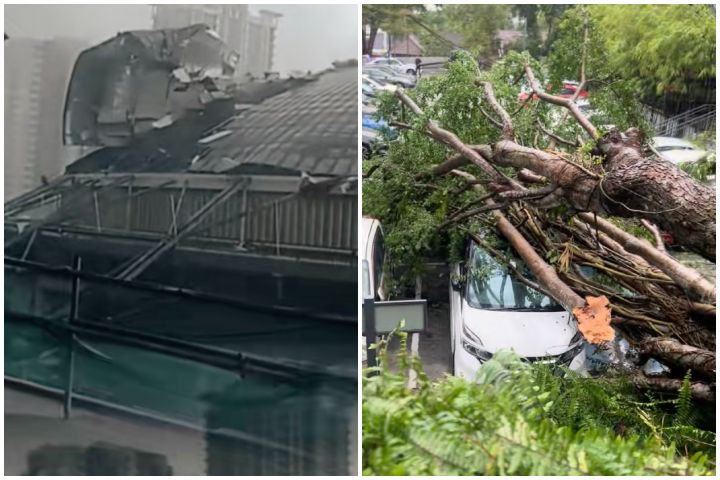By Shahril Bahrom
Copyright therakyatpost

Subscribe to our FREE Newsletter, or Telegram and WhatsApp channels for the latest stories and updates.
A sudden violent storm ripped through the heart of the capital yesterday (22 September) and social media was abuzz with videos of destruction and flying debris.
Malaysians shared numerous videos of the storm all around Kuala Lumpur and surrounding areas, many of which showed dark clouds, heavy rain, and strong winds.
A user on TikTok uploaded a video of the National Stadium’s roof being peeled off by strong winds as though it was paper.
The scene looked as though it came right out of a movie set.
@snizam_tsn Just happen.. #stadiumnegara #ribut #hujanlebat ♬ suara asli – Jeruk.nipis
The stadium’s contractor, PNB Merdeka Ventures Sdn Bhd, released a statement saying they are aware that a portion of the stadium’s roof was dislodged due to strong winds.
“PNB Merdeka Ventures Sdn. Berhad is aware that a portion of the Stadium Negara roof was dislodged due to a heavy rainstorm today.
“Our team is on site to asses the situation. We will continue to monitor closely and provide updates accordingly. The safety of the public remains our utmost priority,” it said in a Facebook post.
Meanwhile, more videos showed the destruction the storm caused in other areas around KL.
Low-cost flat PPR Seri Cempaka in Pantai Dalam also had its roof torn off by the storm, causing a hail of debris to fall.
KL’s transport hub KL Sentral was not spared either as the Plaza Sentral signage at the top of the building became dislodged and fell to the ground.
@apabilamedia Freak storm tore through KL this afternoon, causing chaos. Homes damaged, cars wrecked, even Plaza Sentral’s signboard came loose. Were you affected? #kualalumpur #pantaidalam #storm #hujanribut #apabilamedia #fypmy ♬ original sound – Apabila
In other areas, the rain was was so unrelenting that it uprooted trees, causing them to fall on cars and other roadside property.
@etashashafiq Wehh ribut teruk wehhh. Pokok besar tumbang habis dua biji kereta kena hempas berdekatan dengan tempat kerja aku ni..Samantan ..nyaris jantung aku pun tercabut ni gais🥹maha besar kuasa mu ya allah moga yang baik baik saja untuk mangsa🥲😢😔 #damansarasemantan #manulife #hujanributpetir⛈️⛈️ #22sept2025 ♬ suara asli – Rajuli Almaseid
Meteorological Department: Malaysia may experience short La Niña episode in early 2026
Malaysia could see a brief La Niña episode at the end of 2025 and early 2026, which may affect the country’s rainfall patterns. However, weather conditions are expected to return to neutral not long after, according to the Malaysian Meteorological Department (MetMalaysia).
In a statement, the National Climate Centre under MetMalaysia said its long-term weather outlook for September 2025 to February 2026 shows that most international climate models predict the El Niño–Southern Oscillation (ENSO) will remain in a neutral phase, with a 56% chance of continuing until October.
“These forecasts also take into account global climate factors such as ENSO, the Madden-Julian Oscillation (MJO), and the Indian Ocean Dipole (IOD),” the department said.
Currently, the latest ENSO readings are neutral, with the Oceanic Niño Index (ONI) for May, June, and July 2025 recorded at -0.1°C.
MetMalaysia added that while a short La Niña period may occur early next year, rainfall patterns are likely to stabilise soon after. The phenomenon, if it happens, could influence weather across Southeast Asia, including Malaysia.
At present, the country is still in the tail-end of the Southwest Monsoon. During this time, the southwest winds bring drier conditions and lower humidity, reducing cloud formation and rainfall in many states.
“Even though the weather is drier, there is still a risk of strong winds and thunderstorms, especially in the western parts of Peninsular Malaysia, northern Sarawak, and western Sabah,” MetMalaysia warned.
What is La Niña and how does it affect Malaysia?
La Niña is a natural climate phenomenon that happens when sea surface temperatures in the central and eastern Pacific Ocean become cooler than usual. This cooling shifts global weather patterns, and Southeast Asia — including Malaysia — often feels the effects.
For Malaysia, La Niña usually brings heavier rainfall and wetter conditions. This can increase the risk of flash floods, landslides, and overflowing rivers, especially in flood-prone areas. At the same time, certain parts of the country may experience cooler-than-usual temperatures.
The phenomenon tends to occur every few years and usually lasts for several months. While it can boost water supply for agriculture, it also means Malaysians must stay alert to possible extreme weather, particularly during the monsoon seasons.
Share your thoughts with us via TRP’s Facebook, Twitter, Instagram, or Threads.